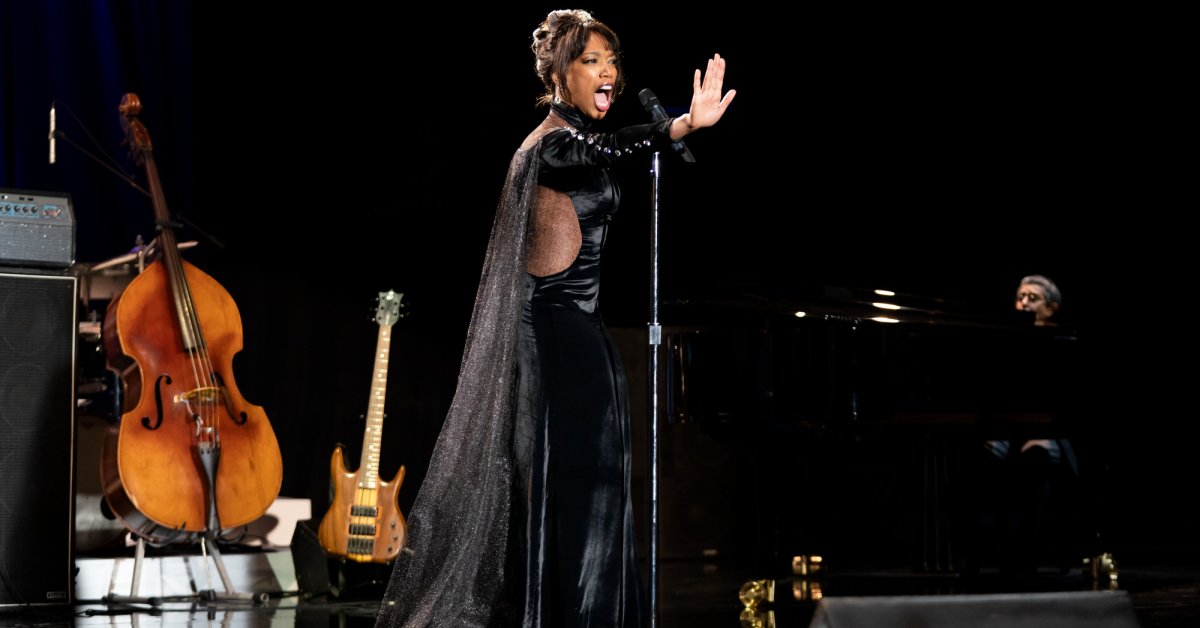Whitney Houston: I Wanna Dance With Somebody, the new biopic from filmmaker Kasi Lemmons, is filled with recreations of the singer’s iconic performances—like her 1991 rendition of the national anthem at the Super Bowl. But the film closes with a scene that pays tribute to one of Houston’s lesser-known appearances: a 1994 performance at the American Music Awards that showcased not only her phenomenal talent, but her range, versatility, and stamina as a live artist.
The performance, a medley arrangement of the classic show tunes, “I Loves You, Porgy” and “I Am Telling You, I’m Not Going,” as well as Houston’s hit, “I Have Nothing,” was the highlight of the night, where Houston took home 8 awards, tying Michael Jackson’s record for the most AMAs won in a year.
At the time, Houston was a commercial success and one of the biggest superstars in the world, not only on the musical charts, but in Hollywood, following the blockbuster success of her silver screen debut in The Bodyguard. With her show-stopping performance at the 1994 AMAs, Houston reminded audiences that above all, she was a vocalist.
Read more: I Wanna Dance with Somebody Captures Both the Tragedy and Glory of Whitney Houston
Cultural critic Gerrick Kennedy, the author of Didn’t We Almost Have It All: In Defense of Whitney Houston, says the medley is an affirmation of Houston’s absolute command of live performance and her title as “the Voice.”
“So much of our love of this particular performance is rooted in the technical feat that is her singing 10 minutes of ballads live on an awards show,” Kennedy tells TIME. “These are three very hard songs to sing, technically and individually, but she does them back to back. It’s just one of those performances that is absolutely out of this world and you think, Whitney is this technical master of a vocalist.”
According to Andrew Mall, an assistant professor of music at Northeastern University, the performance itself is a veritable musical feat, given the length of the arrangement and the vocal range. During the nearly 10-minute performance, there are no instrumental breaks; the only time Houston has to rest is a brief 10-second transition after the two show tunes, when her musicians reset before they launch into “I Have Nothing.”
“The first thing that struck me about it is the athleticism of her singing,” Mall tells TIME. “She’s singing this medley nonstop—it’s almost 10 minutes long, it’s three songs in a row, all of which go through a huge vocal range and there’s a lot of vocal color and interpretation.”
Read more: Fact-Checking the New Whitney Houston Biopic I Wanna Dance With Somebody
Like Kennedy, Mall also points to Houston’s live performance of the medley as an indicator of her outsized musical gift, especially given the circumstances of her life in that moment. At the time, Houston was on a world tour and while she was in performing shape, she also experienced documented health issues, including a miscarriage, which caused her to reschedule shows.
“The live performance for many people is a measure for performers’ true musicianship and their ability to really engage with the music and capture an audience’s attention,” he said. “She’s had these ups and downs with her physical well being and ability to do it, but to bring this substantial, huge live performance for a nationwide broadcast really cements her position as a top diva and a virtuosic performer.”
Mall says the song choices also reinforce Houston’s performance as a memorable one, noting that the selection of two staples of show tunes were not only a testament to her depth and background in singing gospel music that set her apart from many of her peers at the time, but also helped to place her artistic legacy in context as part of a larger musical history.
“These cement her in a lineage of American singers who made singing ballads from musicals like a central part of their career,” he says. “That’s a statement to me—yes, she’s got these diva qualities, she deserves to be at the top of the charts, but she also deserves this larger consideration and a longer lineage of people who aren’t simply pop singers, but also have a lot more depth to their repertoire and to their expression.”
More Must-Reads From TIME



